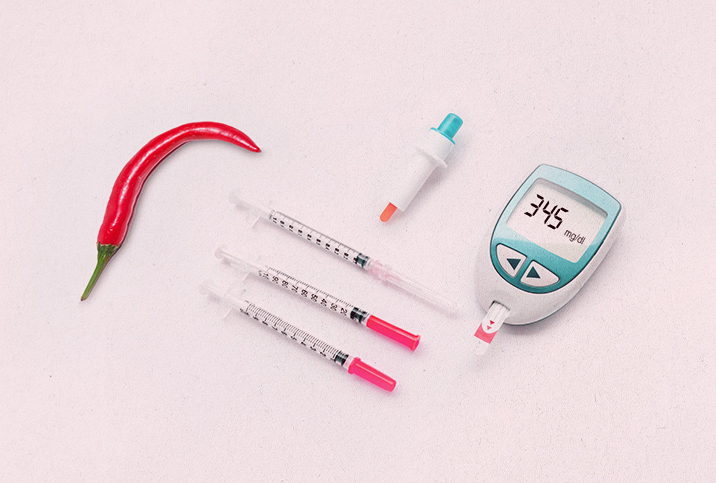Study Suggests Connection Between Uncontrolled Diabetes and Peyronie's

Diabetes may have more impact on your penis than hindering erections, as the disease may also impact its curvature.
Diabetes, the chronic metabolic disease marked by high blood sugar, has long been linked to erectile dysfunction and is among the primary risk factors for developing ED. However, new research indicates diabetes may also be associated with the penile deformity condition known as Peyronie's disease, which involves the buildup of fibrous scar tissue, potentially leading to curved and painful erections.
There is an association between diabetes and Peyronie's disease complications, according to a new study from researchers at Johns Hopkins University in Baltimore. The retrospective study of patients, which was presented during the 2021 Sexual Medicine Society of North America Fall Scientific Meeting, suggests uncontrolled diabetes and a further increase in hemoglobin A1C levels after a Peyronie's diagnosis significantly impacts the severity of the Peyronie's. The A1C test indicates a patient's average blood sugar level over the previous three months. People with diabetes should have this test performed regularly to examine if their blood sugar levels are within the acceptable range.
Arthur Louis Burnett, M.D., a professor of urology at Johns Hopkins School of Medicine and one of the authors of the study, said their objective was to look at a variety of clinical and diagnostic characteristics of diabetes that might potentially predispose men to develop Peyronie's disease.
The researchers identified that a certain extent of penile deformity tends to relate to diabetes.
"Our research has looked to evaluate the various factors of diabetes that are clinically identifiable, such as hemoglobin A1C [and] diabetic complications, and try to make some association with that," Burnett said.
The researchers identified that a certain extent of penile deformity tends to relate to diabetes. According to Burnett, the study has helped clarify how doctors may be able to stratify the likelihood of developing more severe forms of Peyronie's disease based on diabetes characteristics.
"We think we can help men coming in the door with diabetes who have some early-stage Peyronie's, or for those who have diabetes who are concerned about their sexual health, their erection ability and likelihood to have deformity in the penis," Burnett said.
Poor glucose control and impaired healing
The study's conclusions mirror what at least one men's health specialist sees in his clinical practice. Bobby Najari, M.D., a urologist at NYU Langone Health in New York, has noticed that in men with diabetes, especially those with insulin-dependent diabetes, Peyronie's disease can happen at a much younger age. While Peyronie's is most common in men in their 50s and 60s, Najari has had patients with diabetes in their 20s present with the penile disease.
"I definitely see an association between diabetes and Peyronie's disease, and I think based on what we know about diabetes, particularly uncontrolled diabetes, it's intuitive because poor glucose control leads to impaired healing," Najari said, adding that Peyronie's is ultimately a disease of improper healing in the erectile tissue. "It makes sense that the worse your diabetes, the more likely you are to have more significant curvature or more significant scar formation."
Whenever people sustain injuries, the immune system has a role in healing the local tissue damage.
"When you're diabetic, there are derangements in the metabolic and immune regulation of your tissues everywhere—your blood vessels, your nerves, your structures of tissues," Burnett said. "Lo and behold, that's what's going on in your penis."
The penis has blood vessels, nerves and various types of structural tissues susceptible to healing abnormalities. For men to have penetrative sex, their penis has to become erect, and for an erection to occur, many conformational changes occur from the flaccid to the erect state. During sexual activity, the penis sustains movements and force.
"There may be some minor tears that occur in the penile tissue," Burnett said. "Some men heal well. Others have some very abnormal healing processes, and we think that diabetes certainly is an added-on condition that certainly makes that best healing process be even more deranged."
More research needed
Burnett said it's important studies inform people of the risks associated with a disease and the actions they can take. He thinks the next step is to conduct research on what men can do about their diabetes and Peyronie's disease, but he expects this to take a few years.
"I think it stands to reason that those men who are informed early can get better diabetes control and are less likely to have susceptibility to these penile scarring changes and, ultimately, Peyronie's disease," Burnett said. "Better diabetes control likely will lessen this risk."
In future studies, patients would be monitored longitudinally, or over time, Burnett said. These studies would help researchers understand the proportion of men who achieve better diabetes control versus others, as well as the rates of penile deformities that occur in the different groups.
Najari said he thinks it would be helpful for researchers to look at diabetes and Peyronie's disease from the opposite direction. Instead of identifying patients with Peyronie's and then looking at the cohort of those patients who have diabetes, start with patients with diabetes and follow them over time to see which patients develop Peyronie's and the rate of development. ;
"My sense is that a greater number of patients with diabetes develop Peyronie's disease, but I don't have numbers to back that up," Najari said.


















